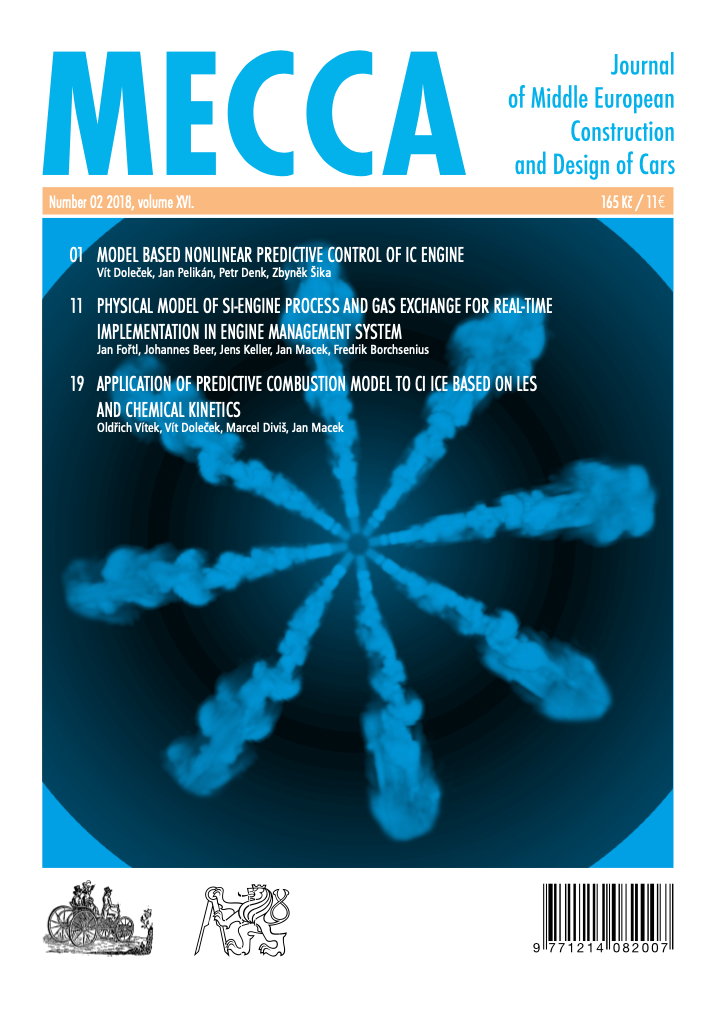PHYSICAL MODEL OF SI-ENGINE PROCESS AND GAS EXCHANGE FOR REAL-TIME IMPLEMENTATION IN ENGINE MANAGEMENT SYSTEM
Keywords:
ENGINE MODEL, GAS EXCHANGE, 1D/0D, ECU, REAL-TIMEAbstract
This paper presents a physical, crank angle resolved model of spark ignited (SI) engine process and gas exchange developed by Continental AG for real‐time engine management system. Transient 1D flow in pipe systems is the most time‐consuming part of the numerical solution. A so‐called detailed model, including intake and exhaust pipe components, is defined and reduced to its fast‐running version where pipes are neglected. Experimental validation confirms that the detailed model captures transient effects and fulfills accuracy targets over the entire engine operation range, while the fast‐running model requires additional empirical parameterization. Both models, however, provide more detailed information on dynamic gas exchange process and the in‐cylinder state for each individual engine cycle than today’s data driven models do (e.g., transient gas states and internal engine exhaust gas recirculation). Finally, simplifications according to classical acoustic theory are proposed for pipe components to solve the conflict between accuracy and real‐time capability.
Tento článek prezentuje fyzikální model čtyřdobého procesu a výplachu zážehového spalovacího motoru. Model byl vyvinut u Continental AG pro účely sériových řídících jednotek. Nestacionární 1D proudění v potrubních systémech je časově nejnáročnější součástí numerického řešení. Proto je nejprve definován podrobný model, zahrnující řešení sacích a výfukových potrubí, který je dále zjednodušen na rychle fungující verzi se zanedbáním zákona zachování impulsu v potrubních systémech. Experimentální ověření potvrzuje, že podrobný model zachycuje přechodové jevy a splňuje cíle přesnosti v celém rozsahu provozu motoru, zatímco zjednodušený model vyžaduje další empirickou parametrizaci. Oba modely však poskytují podrobnější informace o výplachu a termodynamickém stavu ve válcích než to činí běžné datově orientované modely (např. přechodné stavy plynu, nebo vnitřní recirkulace výfukových plynů motoru). Nakonec jsou navržena zjednodušení řešení proudění v potrubích podle klasické akustické teorie s cílem vyřešení rozporu mezi přesností a schopností dosáhnout řešení v reálném čase na daném hardwaru (ECU 240 MHz).
References
Kainz, J.; Beer, J.; Bänfer, O; Nelles, O. Einsatz von lokalen Modell‐Netzen in einer Motorsteuerung zur Modellierung von Ventiltriebsvariabilitäten, Congress „Haus der Technik“ variable Ventilstewuerung, Essen, 2009
Macek, J.; Polasek, M.; Sika, Z.; Valasek M.; Florian
M.; Vítek O. Transient Engine Model as a Tool for Predictive Control, Czech Technical University in Prague, SAE 2006‐01‐0659
Nelles, O.; Bänfer, O.; Kainz, J; Beer, J. Local Model Networks, In: The Prospective Method for Modeling in Electronic Control Units? ATZelektronik 06I2008
Wurzenberger,J.;Reinzle,R.;Schuemie,A.;Katrasnik,T.
Crank‐Angle Resolved Real‐Time Engine Simulation – Integrated Simulation Tool Chain from Office to Testbed, SAE 2009‐01‐0589
Friedrich, I“. Motorprozess‐Simulation in Echtzeit – Grundlagen und Anwendungsmöglichkeiten, TU‐Berlin, Sharker Verlag Aachen, Berlin, 2008, ISBN 987‐3‐8322‐7019‐3
Roesler, C.; Echtzeitfähiges physikalisches Motorprozessmodell – Potenziale für die Steuerung eines Pkw‐Ottomotors, Technical University of Berlin, Berlin, 2013, ISBN 978‐3‐8325‐3359‐5
Ludwig, O.; Eine Möglichkeit zur echtzeitfähihen, physikalisch‐basierten Motorprozessanalyse auf der Grundlage zeitlich fusionierter Messdaten‚ Logos‐Verlag Berlin, Hamburg, 2011, ISBN 978‐3‐8325‐2792‐1
Merket,P.;Schwarz,CH.GrundlagenVerbrennungsmotoren; Simulation der Gemischbildung, Verbrennung, Schadstoffbildung und Aufladung, Vieweg +Teubner, Wiesbaden, 2009, ISBN 978‐3‐8348‐0740‐3
Grill, M. Objektorientierte Prozessrechnung von Verbrennungsmotoren, Institut für Verbrennungsmotoren und Kraftfahrwesen der Universität Stuttgart, Stuttgart, 2006
Pischinger, R.; Kell, M.; Sams, T. Thermodynamik der Verbrennungskraftmaschine, Springer Verlag, Wien, 2009, ISBN 978‐3211‐99276‐0
LeVeque, Randall J. Finite Volume Methods for Hyperbolic Problems, University of Washington, Cambridge University Press, Cambridge, 2004, ISBN 0‐511‐04219‐
Borean, F.; Message, S.; Morgan, CH.; Neaves B.; Slaney, T.; Jaguar Land Rover, Coventry, UK
‐2025 Challenges for Combustion Control
in Automotive World: Hybridization, Emissions and Key Enablers, Symposium for Combustion Control 2016, Aachen
Beer, J.; Koch, A. Injection and IVVT‐Strategy to Improve the Behavior of a Turbocharged Engine with Direct Injection, Siemens VDO Automotive AG, Regensburg, 2003
Huber, E. W. Measuring the Trapping Efficiency of Internal Combustion Engines Through Continuous Exhaust
Gas Analysis, Institut fuer Motorenbau, Detroit, 1971, SAE‐710144
Downloads
Published
Issue
Section
License
Authors who publish with this journal agree to the following terms:1. Authors retain copyright and grant the journal right of first publication with the work simultaneously licensed under a Creative Commons Attribution License that allows others to share the work with an acknowledgement of the work's authorship and initial publication in this journal.
2. Authors are able to enter into separate, additional contractual arrangements for the non-exclusive distribution of the journal's published version of the work (e.g., post it to an institutional repository or publish it in a book), with an acknowledgement of its initial publication in this journal.
3. Authors are permitted and encouraged to post their work online (e.g., in institutional repositories or on their website) prior to and during the submission process, as it can lead to productive exchanges, as well as earlier and greater citation of published work (See The Effect of Open Access).

